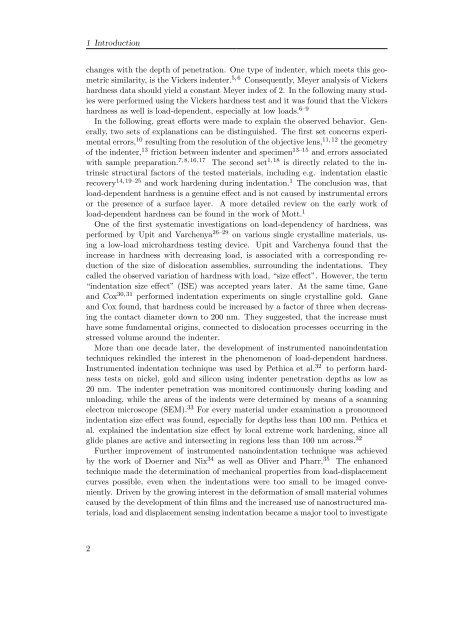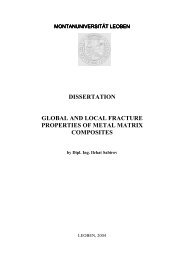Structural Investigation of Size Effects in Plasticity using Indentation ...
Structural Investigation of Size Effects in Plasticity using Indentation ...
Structural Investigation of Size Effects in Plasticity using Indentation ...
You also want an ePaper? Increase the reach of your titles
YUMPU automatically turns print PDFs into web optimized ePapers that Google loves.
1 Introduction<br />
changes with the depth <strong>of</strong> penetration. One type <strong>of</strong> <strong>in</strong>denter, which meets this geometric<br />
similarity, is the Vickers <strong>in</strong>denter. 5,6 Consequently, Meyer analysis <strong>of</strong> Vickers<br />
hardness data should yield a constant Meyer <strong>in</strong>dex <strong>of</strong> 2. In the follow<strong>in</strong>g many studies<br />
were performed us<strong>in</strong>g the Vickers hardness test and it was found that the Vickers<br />
hardness as well is load-dependent, especially at low loads. 6–9<br />
In the follow<strong>in</strong>g, great efforts were made to expla<strong>in</strong> the observed behavior. Generally,<br />
two sets <strong>of</strong> explanations can be dist<strong>in</strong>guished. The first set concerns experimental<br />
errors, 10 result<strong>in</strong>g from the resolution <strong>of</strong> the objective lens, 11,12 the geometry<br />
<strong>of</strong> the <strong>in</strong>denter, 13 friction between <strong>in</strong>denter and specimen 13–15 and errors associated<br />
with sample preparation. 7,8,16,17 The second set 1,18 is directly related to the <strong>in</strong>tr<strong>in</strong>sic<br />
structural factors <strong>of</strong> the tested materials, <strong>in</strong>clud<strong>in</strong>g e.g. <strong>in</strong>dentation elastic<br />
recovery 14,19–25 and work harden<strong>in</strong>g dur<strong>in</strong>g <strong>in</strong>dentation. 1 The conclusion was, that<br />
load-dependent hardness is a genu<strong>in</strong>e effect and is not caused by <strong>in</strong>strumental errors<br />
or the presence <strong>of</strong> a surface layer. A more detailed review on the early work <strong>of</strong><br />
load-dependent hardness can be found <strong>in</strong> the work <strong>of</strong> Mott. 1<br />
One <strong>of</strong> the first systematic <strong>in</strong>vestigations on load-dependency <strong>of</strong> hardness, was<br />
performed by Upit and Varchenya 26–29 on various s<strong>in</strong>gle crystall<strong>in</strong>e materials, us<strong>in</strong>g<br />
a low-load microhardness test<strong>in</strong>g device. Upit and Varchenya found that the<br />
<strong>in</strong>crease <strong>in</strong> hardness with decreas<strong>in</strong>g load, is associated with a correspond<strong>in</strong>g reduction<br />
<strong>of</strong> the size <strong>of</strong> dislocation assemblies, surround<strong>in</strong>g the <strong>in</strong>dentations. They<br />
called the observed variation <strong>of</strong> hardness with load, “size effect”. However, the term<br />
“<strong>in</strong>dentation size effect” (ISE) was accepted years later. At the same time, Gane<br />
and Cox 30,31 performed <strong>in</strong>dentation experiments on s<strong>in</strong>gle crystall<strong>in</strong>e gold. Gane<br />
and Cox found, that hardness could be <strong>in</strong>creased by a factor <strong>of</strong> three when decreas<strong>in</strong>g<br />
the contact diameter down to 200 nm. They suggested, that the <strong>in</strong>crease must<br />
have some fundamental orig<strong>in</strong>s, connected to dislocation processes occurr<strong>in</strong>g <strong>in</strong> the<br />
stressed volume around the <strong>in</strong>denter.<br />
More than one decade later, the development <strong>of</strong> <strong>in</strong>strumented nano<strong>in</strong>dentation<br />
techniques rek<strong>in</strong>dled the <strong>in</strong>terest <strong>in</strong> the phenomenon <strong>of</strong> load-dependent hardness.<br />
Instrumented <strong>in</strong>dentation technique was used by Pethica et al. 32 to perform hardness<br />
tests on nickel, gold and silicon us<strong>in</strong>g <strong>in</strong>denter penetration depths as low as<br />
20 nm. The <strong>in</strong>denter penetration was monitored cont<strong>in</strong>uously dur<strong>in</strong>g load<strong>in</strong>g and<br />
unload<strong>in</strong>g, while the areas <strong>of</strong> the <strong>in</strong>dents were determ<strong>in</strong>ed by means <strong>of</strong> a scann<strong>in</strong>g<br />
electron microscope (SEM). 33 For every material under exam<strong>in</strong>ation a pronounced<br />
<strong>in</strong>dentation size effect was found, especially for depths less than 100 nm. Pethica et<br />
al. expla<strong>in</strong>ed the <strong>in</strong>dentation size effect by local extreme work harden<strong>in</strong>g, s<strong>in</strong>ce all<br />
glide planes are active and <strong>in</strong>tersect<strong>in</strong>g <strong>in</strong> regions less than 100 nm across. 32<br />
Further improvement <strong>of</strong> <strong>in</strong>strumented nano<strong>in</strong>dentation technique was achieved<br />
by the work <strong>of</strong> Doerner and Nix 34 as well as Oliver and Pharr. 35 The enhanced<br />
technique made the determ<strong>in</strong>ation <strong>of</strong> mechanical properties from load-displacement<br />
curves possible, even when the <strong>in</strong>dentations were too small to be imaged conveniently.<br />
Driven by the grow<strong>in</strong>g <strong>in</strong>terest <strong>in</strong> the deformation <strong>of</strong> small material volumes<br />
caused by the development <strong>of</strong> th<strong>in</strong> films and the <strong>in</strong>creased use <strong>of</strong> nanostructured materials,<br />
load and displacement sens<strong>in</strong>g <strong>in</strong>dentation became a major tool to <strong>in</strong>vestigate<br />
2
















